When I was writing up my recent Second Age Primer article, I kept wanting to say more about Galadriel. But here’s the thing. Her role in the events of the Second Age is nebulous. Even in The Silmarillion, which is mostly about the First Age, we don’t have very much. We’re introduced to her in Valinor, where she is already grown. She is one of the children of Finarfin and Eärwen. As such, she is royalty, the granddaughter of Finwë, High King of the Noldor. She is also there at the Darkening of Valinor, when Melkor and his gal-pal Ungoliant murdered the Two Trees that gave power and light to the Blessed Realm—before there was even a Sun and Moon.
I have written about Galadriel before—five years ago in “The Trial of Galadriel,” with an emphasis on her long-term arc—but here I’d like to focus on her actions in the Second Age. You know, just like Amazon’s The Rings of Power is doing. The new series is taking liberties with the character, as will become quickly apparent. In fact, they have to. But it’s still worth knowing what Tolkien had in mind in his “continual refashionings” of Galadriel’s narrative, if only because the showrunners are well aware even of material they cannot use.
It could be asked, who has it in for Sauron the most? Where? And with what? Was it the Lady of the Golden Wood, in the Lórinand Conservatory, with the Lead Pipe?

First, it must be understood that there is very little solid lore that tracks Galadriel’s movements in the Second Age. I say solid because when it comes to Tolkien’s legendarium, everything he wrote can be considered canon (“the authentic works of a writer”) and yet it doesn’t all agree. This is just a fact that all fans have to square with. Most of his stories, histories, and characters were in a constant state of revision—and none more than Galadriel. Keep this in mind when you’re watching The Rings of Power.
In fact, in 1980’s Unfinished Tales, his son Christopher Tolkien even writes this right up front in the chapter specifically about her:
There is no part of the history of Middle-earth more full of problems than the story of Galadriel and Celeborn, and it must be admitted that there are several inconsistencies ’embedded in the traditions’
None of Tolkien’s pre-LotR works included Galadriel. He hadn’t invented her at all until he was writing about the Fellowship’s arrival in the woods of Lórien. But after The Lord of the Rings? Well, now she was there, staring him in the face, demanding to be placed in all that ancient history he’d been laboring over for years. She was like a golden wrench thrown into the works—valuable but complicating. Tolkien had obviously made her important. So he began to retcon her into the Elder Days. Retconning is something writers do. It’s fine. They get to. It’s not even weird, it’s normal. And he was generally very good at it. Still, what he was devising for Galadriel was, ultimately, not only unfinished but also wildly varied.
Speaking of varied, have you ever seen the 1985 film Clue? It’s a brilliant mystery comedy and also the best film based on a board game ever. And who doesn’t love Tim Curry?
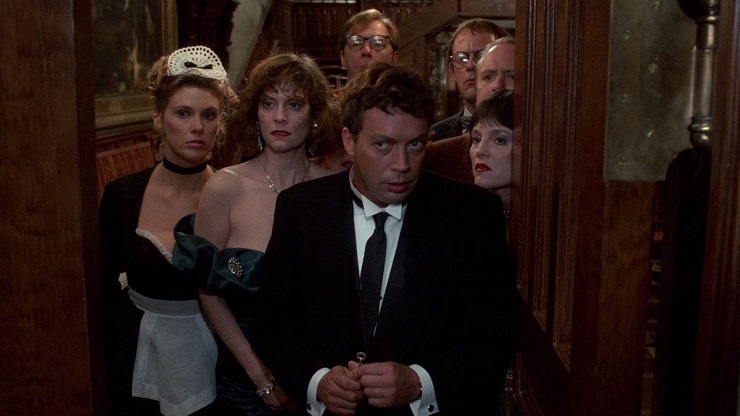
If you’d caught the actual original theatric release, you’d have seen one of three different endings, depending on which theater you saw it. But if you watch the film on DVD or stream it somewhere, you’ll see that it has multiple endings built right in, presented as alternatives. Just when the killer is revealed and apprehended—Ending Possibility #1—and it seems like the end credits are about to roll, we get a bit of cheery music with a black title card filling the screen, saying:
That’s how it could have happened.
Ah-hah. This implies that this is not what happened, just one way it could have gone. All right. Then we immediately get a second card:
But how about this?
Then we watch as a bit of the previous segment of the movie plays out but this time a different person is revealed as the killer—Ending Possibility #2! And when that finishes, we get one more card:
But here’s what really happened.
This is the more surprising, hilariously convoluted, and better Ending Possibility #3. And it’s even been presented as the real one.
Well, this is sort of how one must regard the story of Galadriel outside the bounds of The Lord of the Rings and its Appendices. Except it’s not about endings but beginnings. And we never get a definitive “here’s what really happened” message from Tolkien. We get a series of parallel-dimension Galadriels, each with her own primary objective, methods, and uncertain routes. Even though her place of birth remains the same—Valinor, in the Undying Lands—her husband’s Elf-brand and place of origin keeps changing. He’s a wood-elf, like those in Mirkwood. No, he’s a Sindarin prince from Doriath! No! He’s a Telerin Elf from Alqualondë! Whoa!
Each Galadriel may differ significantly from the next, but each is still compatible, in her own way, with the one that Frodo meets and tempts with the One Ring, the one who chooses to diminish and go into the West and remain just Galadriel. She is never a Queen, “beautiful and terrible as the Morning and the Night,” “whom all shall love and despair” …if she chooses it.
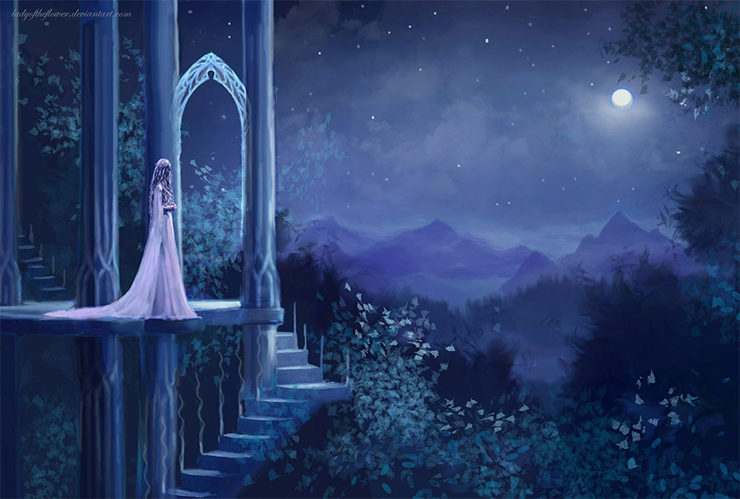
The closest thing we might get to a “final” Galadriel from Tolkien’s later writings is one that he summarized—as Christopher explains—in the last month of his life. That one’s actually the most surprising of them all, actually; one that makes her not merely a participant in major events but an exalted mover and shaker. Yet even that Galadriel remain suspect, because if Tolkien successfully had retconned that version of her story into The Silmarillion, he’d have had to change so much more. And it would, on the whole, be a very different book than the one we know.
But before we talk about any of these versions, let’s just work backwards with what we know about her movements in the Second Age from The Lord of the Rings. This was the launching point for Rings of Power’s Galadriel as led by showrunners JD Payne and Patrick McKay. That is to say, it’s this late-Third-Age Galadriel from which they’ve reverse-engineered a new past for their series. An alternative one, yes. The history and motives of Galadriel in the show are new, and we’ll each get to decide how true to the spirit of Tolkien she is.
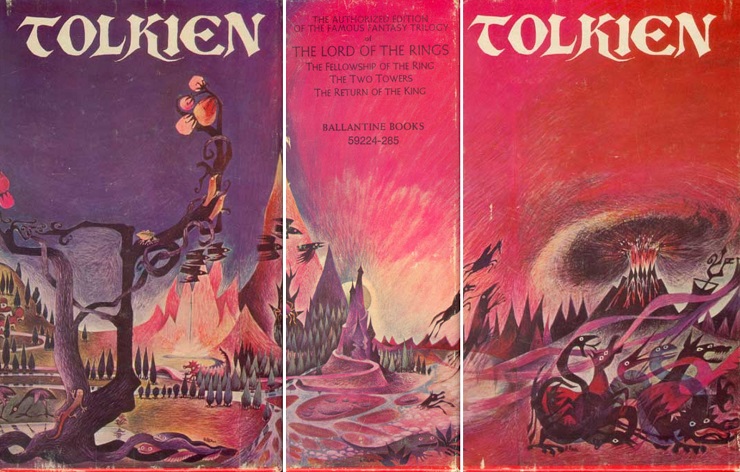
What We Know from The Lord of the Rings
Just after Galadriel charms Gimli by listing travel-guide landmarks in the Dwarven tongue, she points out that she wasn’t always in Lothlórien. She brings this up not by talking about herself, but her husband. I always find this poignant. For all that we make fun of Celeborn (who can blame us?), one person who never does is his wife. She speaks of his wisdom and power, and then…
He has dwelt in the West since the days of dawn, and I have dwelt with him years uncounted; for ere the fall of Nargothrond or Gondolin I passed over the mountains, and together through ages of the world we have fought the long defeat.
Look at Galadriel namedropping Silmarillion locations like her son-in-law, Elrond! If you don’t know those two long-lost Elf-realms, it’s fine. We don’t need to know them for her story. The mountains she speaks of are the Blue Mountains, and those do matter. They once separated the regions of Beleriand (a vast section of the continent now sunken beneath the waves) and Eriador. Later, from the words of Galadriel’s song at the company’s departure from Lothlórien, it’s clear she once lived in Valinor and yearns for it again. So she was born there, in the Undying Lands across the Great Sea Belegaer, and Celeborn was born on Middle-earth. Yet the Sea clearly calls to her… the Sea that could carry her back to her homeland.
But if of ships I now should sing, what ship would come to me,
What ship would bear me ever back across so wide a Sea?
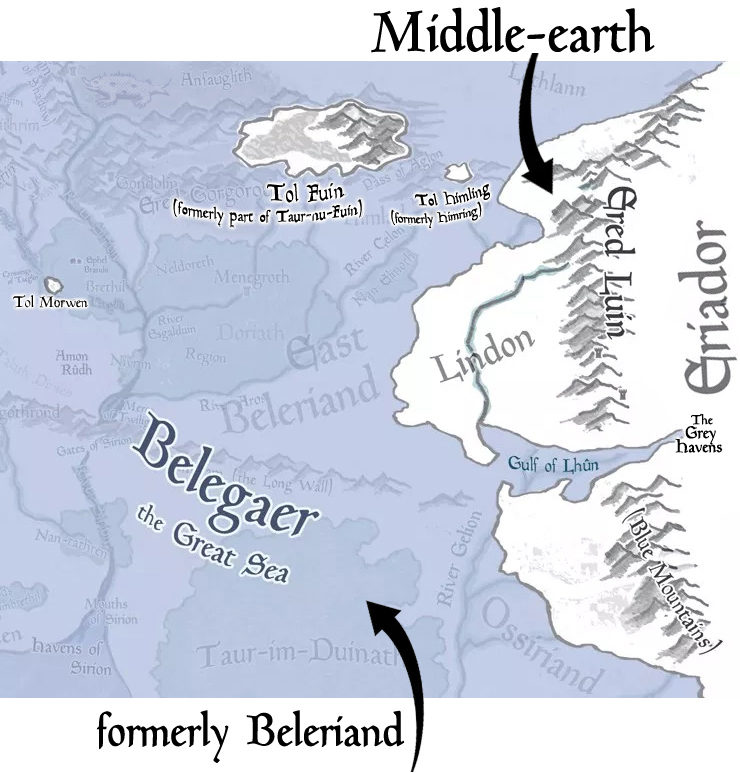
Much later, in Appendix B, we’re told that Celeborn and Galadriel were already married by the start of the Second Age. Back then, both of them lived “south of the Lune” (the river that feeds the Gulf of Lhûn) in the realm of Lindon in the Second Age (which the High King Gil-galad ruled). But they were only there for a few hundred years, a mere vacation for Elves. Galadriel has a daughter, Celebrían (who became Elrond’s wife and the mother of Arwen), but we don’t know how old she was or when she was born—at least not from this book; outside sources place Celebrían’s birth around 300 of the Second Age. Which further reinforces the idea that Galadriel’s been married to Celeborn for quite a long time even at the start of the Second Age.
Yet, in The Rings of Power show, Celeborn himself is simply not in the picture. So they’ve obviously altered that timeline as well.
Buy the Book


Into the Riverlands
The Appendices tell us that Sauron’s servants and allies do eventually attack Lothlórien during the War of the Ring, even though we don’t get a hobbit’s-eye-view of that, and that his army is repelled each time by the “valour of the elven people” and the “power that dwelt there” (i.e. Galadriel and her ring). Sometime afterward, Celeborn leads Galadhrim forces out to Dol Guldur, the stronghold the enemy had been attacking from, and they mop the floor with Sauron’s Mirkwood minions. And then comes that wonderful but tantalizingly brief sentence that, I wish, was its own full tale:
They took Dol Guldur, and Galadriel threw down its walls and laid bare its pits, and the forest was cleansed.
I mean, she’s not doing that with swords and battering rams. She’s got to be using some old-school, Calaquendi, she-saw-the-Light-of-the-Two-Trees-with-her-own-eyes Elven arts. Maybe even with the power of song, as Lúthien had once done, as many Noldor had done in ancient times. What would Samwise say to witnessing that kind of “Elf-magic”? I wonder.
Anyway, when the War of the Ring is over and Frodo’s quest is achieved, Lothlórien’s power begins to fade (because Galadriel’s ring loses its own power), and she finally has no reasons left to remain in Middle-earth. Galadriel is able to heed the call of the Sea at last. Thus she sails into the West with some other noteworthy passengers.
So now let’s look elsewhere, and further back in time. But remember, the information that follows comes from sources outside what The Rings of Power can do with Galadriel. That is to say, the show will not be able to adapt any of these variations directly. (The Tolkien Estate did not, or would not, give Amazon the full rights to it.) But did they take inspiration from this other stuff? Does this material exist as a spiritual or moral basis for the decisions the showrunners, the writers, and the actress Morfydd Clark are making about the character of Galadriel? Almost certainly. Just read on. Or better still, read Tolkien’s text.
In all iterations of Galadriel—the “maiden crowned with a garland of bright radiance”—she is fighting the long defeat. How she is doing so, it would seem, is a matter of a reader’s imagination or a showrunner’s adaptation.
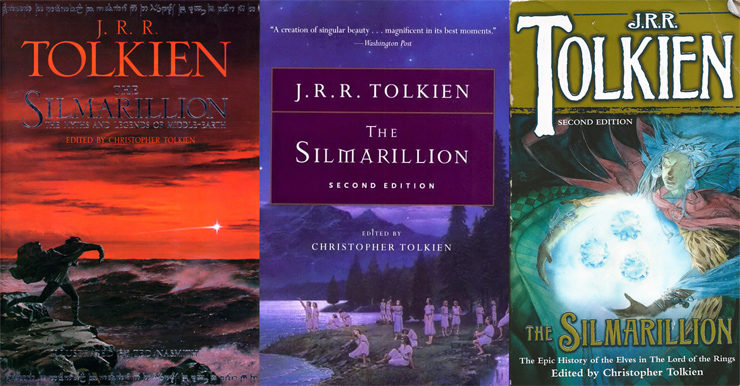
What We Know From The Silmarillion
In the published Silmarillion, we know Galadriel was present in Valinor when her half-uncle Fëanor made his ill-advised Oath and fanned the flames of rebellion. She was no Fëanor fan but she, too, desired to go to Middle-earth and govern a realm of her own. She had big ideas. Galadriel had no personal grudge against the Valar (like Fëanor does) or inherent desire to revolt against them, but she did want to leave very much, thank you. It’s a matter of opportunity and pride. So she was counted as one of the actors of that rebellion.
During the tragic Kinslaying in Alqualondë that follows, Galadriel was in the back of the second host of the Noldor and in the company of her father, Finarfin. Therefore she took no part in the bloodshed against the Teleri (her own mom’s people!) and the stealing of their famous swan-ships. She probably wasn’t even aware of its happening until it was over. But she did join her four brothers, anyway, in the great exodus of the Noldor that followed. She, too, braved the long and frozen hellscape called the Helcaraxë that led to Middle-earth. Galadriel’s parents ended up staying behind, so it would be thousands upon thousands of years before she would see them again. Every time the subject of Galadriel’s chance of going home comes up—to return to Valinor, where she would be able to be with them again—I think of Finarfin and Eärwen. Maybe it was worse for them.
The Noldor who chose to press on even after the Kinslaying, which was most of them, were given a last warning. Because of the bloodshed, woe now awaited them in their future; this was called the Prophecy of the North or the Doom of Mandos. Galadriel and a whole bunch of her friends and family may have shed no Elf-blood like Fëanor and his followers had, but theirs was still guilt by association. She might not have robbed the bank and shot the security guard, but when the Elf who did commit the crime ran out with the money and blood on his hands, she followed him. She didn’t turn herself in.
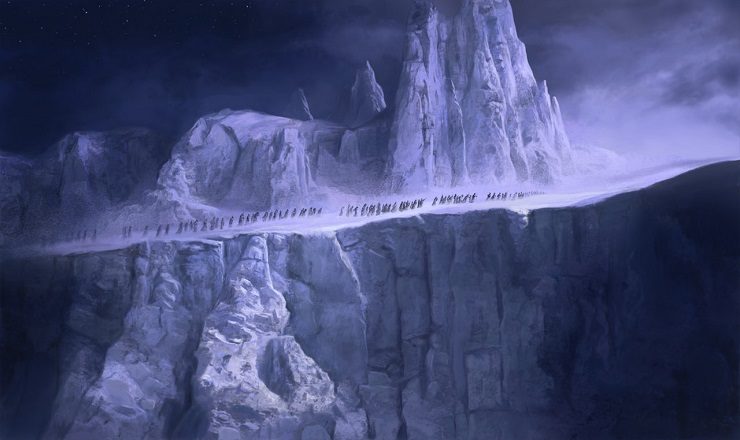
Therefore when the Noldor—even the “innocent” ones—press on, and follow in the wake of Fëanor, their self-imposed exile becomes a proper ban.
There’s no mention of Galadriel taking part in most of the First Age events thereafter, certainly not in the great battles. Which doesn’t mean she didn’t learn how to fight or even have cause to fight at some point. The First Age is a centuries-spanning, war-torn period of time. And I would argue that every royal in the house of Finwë would have learned to take up arms at need. Especially since swords and armor became a thing specifically because Melkor himself (aka Morgoth, the Dark Enemy of the World) once moved among them with a fair face and a silver tongue and encouraged them to arm up (specifically in order to sow dissent). Galadriel’s own uncle, Fingolfin, would later take on Morgoth himself in single combat. Fëanor would take on Balrogs. Both held their own (even if they lost). Even her dear brother Finrod, after all his own adventures and defiance of the Enemy, would personally wrestle a werewolf with his bare hands and win a pyrrhic victory. My point being, Galadriel needs no fainting couch. But we’ll learn that not so much in this book as in Unfinished Tales.
We’re told that Galadriel ended up living in the kingdom of Doriath, in the court of King Thingol and Queen Melian. In fact, the Maia queen became a kind of mentor to her. Galadriel also met and married Celeborn there in that well-guarded forest realm. Here, Celeborn was a “kinsman” of Thingol himself. Thingol being the brother of Galadriel’s grandfather in Alqualondë. So yeah, Galadriel and Celeborn were actually relatives, but rather distant ones. It’s… fine.
There’s no more talk of her actions or location until after the War of Wrath that ended the First Age. We’re only told that she chose to remain in Middle-earth, that she was unwilling to “forsake the Hither Lands where they had suffered and long dwelt” when the other surviving Noldor were finally allowed to return to Valinor. They’ve all been pardoned.
This, at least, maps to The Lord of the Rings, where she and Celeborn lived in the kingdom of Lune under the rule of Gil-galad. As far as the rest of the Second Age, through the events of the making and fighting over the Rings of Power, we’re only told that one of the Three Rings, the Ring of Adamant (Nenya), is given to Galadriel who already by this time has been governing Lórien alongside Celeborn. She may have played no part in the founding of Eregion but soon moved along to the realm of Lórinand, what would be known as Lóthlorien later on.
Then for the Third Age, she comes up again. Tolkien points out that she was involved in the forming of the White Council and had wanted Gandalf to be its head. But Saruman was chosen instead. And oh yeah, about Gandalf: Only Círdan, Elrond, and Galadriel knew where he came from, so while it might not have been explained thoroughly to them that he was a Maia (like Melian, like Sauron), he at least came from Valinor. So they know he’s obviously part of some secret ops. And Elves are good at keeping secrets.
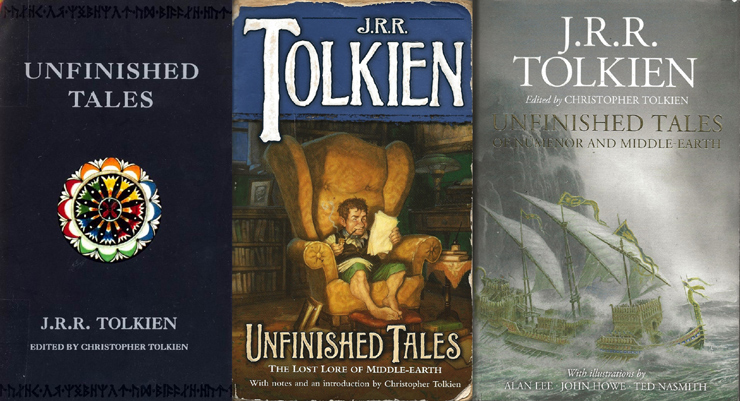
What We Know from Unfinished Tales
Unfinished Tales is where all the good stuff is, most of it under Part Two, Chapter IV: “The History of Galadriel and Celeborn.”
Not only does it give us the Clue-ish what-ifs for Galadriel’s past, it also comes with a whole lot more about the goings-on in Eregion when Sauron was doing his whole hey-what-if-we-all-made-rings-together project. It’s got more to say about Celebrimbor and the Rings of Power than the actual “Of the Rings of Power and the Third Age” section of The Silmarillion. BUT: Very little of this, if any, will be making it into The Rings of Power show, because rights. And it’s a shame, as it’s all excellent (and sometimes zany) stuff.
Christopher Tolkien, who was directly responsible for publishing his father’s work from The Silmarillion onward, used that book as a point of reference for the various takes on Galadriel. So in all versions of her, she was from Valinor first and foremost. She was one of the Calaquendi, the Elves of Light, who saw the Two Trees with her own eyes before they were destroyed.
And with all that in mind…
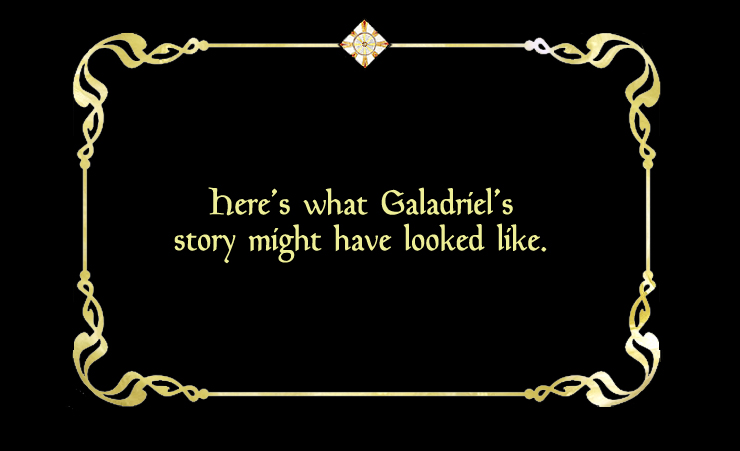
Galadriel was “the greatest of the Noldor,” second only to Fëanor (the one who made the Silmarils). But she was the wiser. Her mom named her Nerwen, which meant “man-maiden.” An unflattering name to contemporary modern ears, no doubt, but it was about her physicality and her height. She was likely 6’4″ and was a “match for both the loremasters and the athletes” among Elves in the early days of their race.” Her dad named her Artanis, which meant “noble woman.” She was “accounted beautiful even among the Eldar.”
Her lustrous golden hair, touched with silver, was “held a marvel unmatched,” as if the mingled lights of golden Laurelin and silver Telperion “had been snared in her tresses.” Some claim that this is what inspired Fëanor to create the Silmarils in the first place, this idea of imprisoning the light of the Two Trees. He asked her on three occasions for a lock of her hair, but she always denied him. Which, of course, makes her later gift to Gimli all the sweeter.
When the Two Trees of Valinor were destroyed and the Blessed Realm became darkened by the actions of Morgoth, she “had no peace within” ever after. She was already proud, strong, self-willed, and had dreams of faraway places—sharing some of these traits with her brother Finrod especially. But unlike him, she was just itching to go. So Galadriel joined in the rebellion of the Noldor against the Valar. She willfully set down the road to exile and was a participant of the tragic Kinslaying. But in that horrible conflict, she “fought fiercely against Fëanor in defence of her mother’s kin.”
Meaning… what?… she fought other Noldorin Elves, the ones who were loyal to Fëanor? Yeah, probably! Given how new bloodshed was to all the Elves in Valinor, though, I personally imagine her doing lots of parrying and shoving, not so much slaying. And look, she’s going to be using a sword and wearing armor. These are Noldor we’re talking about. Don’t think she’s walking around barefoot in white robes and just waving her arms around in combat.
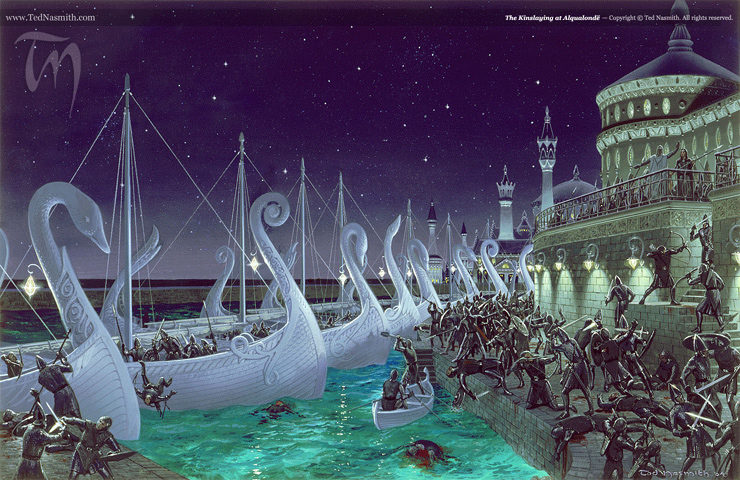
Galadriel was basically the president of the We Hate Fëanor club, especially after crossing this line. She was resolved to following him into Middle-earth just to thwart him. This is called out as one of her chief motivators, or at least, that’s what she was telling herself. Remember, she wanted to go anyway. She is hot with pride. Then, when the Valar issued their warning against their going, especially under such bloody circumstances, and they went on anyway, Galadriel fell under the Doom of Mandos as all the rest did. She did not repent and turn back, as did her father and a few others.
There is no mention of Doriath and Melian this time around, so who knows where she was for most of the First Age? Hundreds of years later, when Morgoth was finally defeated, Galadriel refused the pardon of the Valar when it was offered to all the surviving Noldor. She was still too proud to go back. So then the Second Age went by and she was… somewhere else? Largely uninvolved again, in this account.
Finally, in the year 3019 of the Third Age, all that she ever dreamed of was within her grasp: The One Ring itself was before her and “the dominion of Middle-earth” could have been hers! All right there for the taking, in the quiet offering of Frodo of the Shire. But she wasn’t the same Elf she was in Valinor. No longer as proud, Galadriel rejects Sauron’s Ring. She’d clearly been thinking about this for a long time. She passed the test. Now she could return to Valinor, yay!
The end.
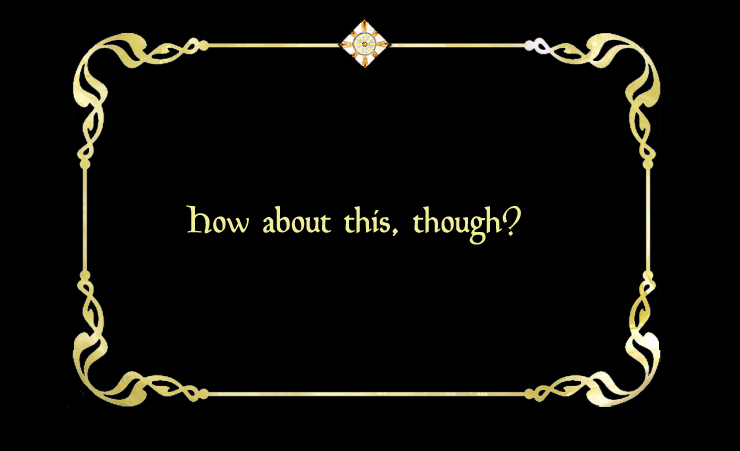
In a letter written less than a year before his death (#348 from The Letters of J.R.R. Tolkien), Tolkien wrote the following of Galadriel when explaining her name:
It is a secondary name given to her in her youth in the far past because she had long hair which glistened like gold but was also shot with silver. She was then of Amazon disposition and bound up her hair as a crown when taking part in athletic feats.
Given the timing, he may have had the following version of Galadriel in mind.
She was powerful and upstanding in Valinor, right from the get-go, “equal if unlike in endowments of Fëanor.” She was “brilliant in mind and swift in action,” and she seemed to have been some kind of valedictorian among her people. Galadriel eventually “absorbed all of what she was capable” of learning from the Valar and ended up feeling “confined in the tutelage of Aman.” She was all potential energy, a coiled spring desperate to go kinetic. Here, her desire to go to Middle-earth and govern a realm of her own had less to do with the heart-stirring words of Uncle Fëanor and more to do with her innate desire to teach others and be an authority in her own right. Manwë, the King of the Valar himself, is mentioned as being aware of this desire in her. He neither forbade her to leave Valinor nor gave her “formal leave to depart.”
You might say the matter was up… in the air.
So she was actually planning on leaving Valinor anyway. Independently from the Noldor. A very forward-thinking Galadriel, this one. (Maybe a little excessively so.) She thought about the ships of her mother’s people (the Teleri), which sure would be a good way to make her way in the wider world, so she went to live in Alqualondë where it sat by the Sea. There she met and married Celeborn—in this version he’s straight-up a Telerin prince—and together they made plans to sail to Middle-earth. Maybe it was meant to be their honeymoon voyage? Just guessing.
No scofflaw in this version, Galadriel planned to seek permission from the Valar to sail off.
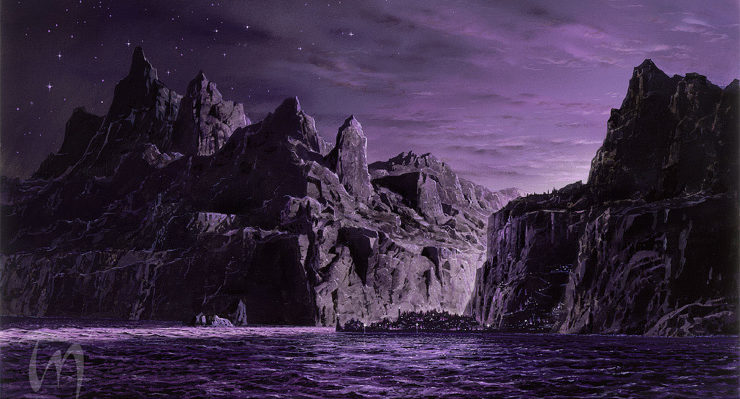
But her timing was awful.
Morgoth then went and destroyed the Trees, with Ungoliant’s help, then stole the Silmarils. Then Fëanor made things worse, spouted his terrible oath, and whipped the Noldor into a rebellious frenzy. All this while Galadriel had been preparing to leave. GAH! Now it’s going to look like she was part of this mess! When Fëanor came for the ships of the Teleri in Alqualondë, intending to use them to cross the Sea, Galadriel was already there. She and Celeborn stepped up and “heroically” fought back, defending her mother’s people in the Kinslaying. I’d like to think they managed to at least minimize the body count.
They definitely were able to spare Celeborn’s ship from Fëanor and his goons. That’s right, Celeborn had his own personal ship! Who saw that coming?
Galadriel and Celeborn hopped in and sailed off into the darkness. Horrified by what had become of Valinor and the violence of her uncle, they determined to voyage across the Sea ahead of Fëanor. So here we have Galadriel leaving Valinor quite a bit earlier than the rest of the Noldor, and again, had planned to do so anyway. Yet under the circumstances, and because she never did get around to asking permission from the Valar in all the confusion, the two of them fell under the same ban as all the departing Noldor. That is, they could leave, but they weren’t allowed to come back if even if they tried. Bad Noldor!
When they reached Middle-earth, they met Círdan the Shipwright at the coastline of Middle-earth. (Doesn’t everybody?) They judged that Morgoth (who by this time would be firmly ensconced in his fortress of Angband) would never be overthrown without the help of the Valar. Somehow they just… knew. They’re very wise, maybe a little too conveniently so? This, though, is why they never joined in the fruitless wars against the OG Dark Lord. It’s also why this version of Galadriel never settled in Doriath in the court of King Thingol (as she does in the published Silmarillion), and never becomes besties with Queen Melian. Instead, she and Celeborn took their honeymoon further eastward, clear out of Beleriand altogether, with the intent to establish defenses against evil on the other side of the Ered Luin (Blue Mountains). They figured east was the direction from which Morgoth would be pulling reinforcements in his wars with the Elves of Beleriand (which was true). But they were doing this on their own; none of the elves of Beleriand would follow.
The First Age thus proceeded as we read elsewhere, and Galadriel and Celeborn were simply not present for the big events. They had, well, exited stage left. One wonders if, when Morgoth was drawing in his armies of Men in the latter half of the First Age (the Easterlings and such), Galadriel was actually able to erode his forces somehow. Might things would have gone worse for Beleriand had she not been there? Whatever the truth, when Morgoth was finally defeated at the end of the First Age, the happy couple were then officially allowed to return to Valinor. But they declined. No particulars given.
This is all drawn from the summary Tolkien wrote “in the last month of his life,” according to Christopher. Of course, this version is drastically at odds with The Lord of the Rings and the published Silmarillion. Christopher explains that this account had more to do with his father’s “‘philosophical’ (rather than ‘historical’) considerations” of Galadriel’s character. Even so, all signs pointed to Tolkien wishing to put in the work to realize this version of Galadriel.
Even if so much else would have had to change because of it.
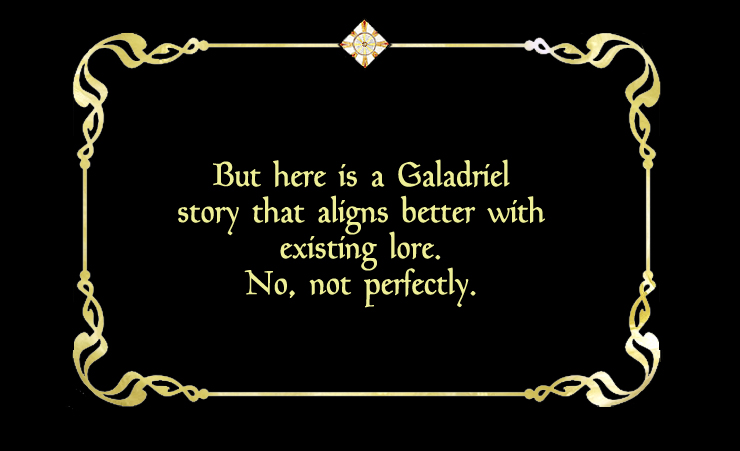
And this one’s much more thorough, too.
Her First Age involvement is essentially that which we read in The Silmarillion. In this version, Celeborn is back to being a Sindarin prince from Doriath, a kinsman of King Thingol. He was never in Valinor, had lived his whole life thus far in Middle-earth. Then, when Morgoth was defeated and the surviving Noldor were pardoned and allowed to sail back to Valinor, she chose to remain. Yes, her pride still likely played a part, but it’s primarily for “love of Celeborn, who would not leave Middle-earth,” that she didn’t go West. See that? She had the chance to go back right then and there, to walk again in the bliss of the Undying Lands and reunite with her parents and all four of her brothers (who had been slain one by one in the wars with Morgoth). But Galadriel doesn’t go, because Celeborn wasn’t ready. This is true love. You think this happens everyday?
So they went into Eriador at this point, and lived among three different groups of Elves: the Noldor who had also chosen to remain (fewer though they are); the Sindar, the Grey-elves; and Green-elves who had formerly lived in the land called Ossiriand (what was now Lindon). Together they lived for a few hundred years around Lake Nenuial (aka Evendim, the Lake of Twilight), north of where the Shire will one day be. Here, Celeborn and Galadriel were regarded as the Lord and Lady of all the Elves of Eriador. Even a bunch of Nandor—another subgroup of Elves who originally gave up the journey to Valinor—flock to their leadership. They’re Elf-magnets, top of the hierarchy.

Interestingly, in this version, Galadriel and Celeborn also have a son: Amroth. Remember him? We first learn about him from that song that Legolas sings when the company reaches the river Nimrodel. ♩ “An Elven-maid there was of old…” ♫ Well, Amroth, in this version of Galadriel’s story, was their firstborn, and Celebrían would be his kid sister. (This doesn’t quite feel right, and the fact is, Tolkien makes no mention of Amroth as Galadriel’s child in The Lord of the Rings, anyway. You’d think that would come up.)
Now, Galadriel is also the one who first perceived that Sauron was a problem in the Second Age, though not in such words. Keep this in mind when watching The Rings of Power.
In some ways, this steals a bit of thunder from Gil-galad, who in most other places is the character most perceptive about the lurking Shadow. In any case, no one could really see that there was a singular being behind the “residue evil” that remained in the world after Morgoth’s removal. But it was Galadriel who felt that there was an “evil controlling purpose abroad,” and that it seemed to stem from the east, beyond the Misty Mountains. Because of this, Galadriel and Celeborn were the ones to move eastward and establish the realm of Eregion. This is around the year 700, long before Sauron comes nosing around the place. This even tracks with the Appendix B timeline from The Lord of the Rings.
It’s even suggested that Galadriel might have chosen Eregion’s location because Khazad-dûm was its next-door neighbor—and who better to borrow a cup of sugar or a lawn mower from than the Dwarves? She was “far-sighted” in this, more so than her husband, and understood that the peoples of Middle-earth would need to work together against this new threat. It’s even said that Galadriel “looked upon the Dwarves also with the eye of a commander, seeing in them the finest warriors to pit against the Orcs.”
With the eye of a commander. I love that. Does that mean she was some kind of military captain, or is this just metaphorical? Either way, it works. No matter how you approach Galadriel, she is a leader to the core.
All right, so when does she actually cross the Misty Mountains and start putting down roots in the woods of Lórinand (future Lothlórien)? She’s got to end up there somehow, right? Those mallorn-trees aren’t going to plant themselves!
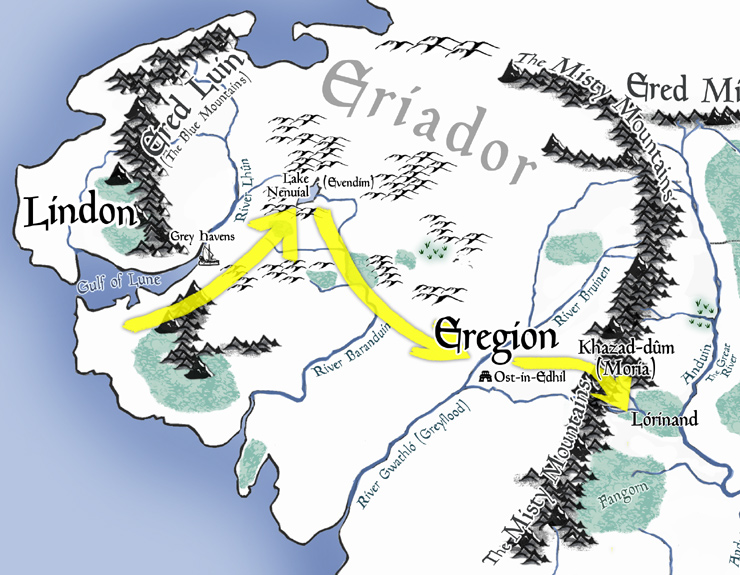
Right, right, but I’m not done with the Dwarves yet. In her kinship with the bearded folk of Khazad-dûm, Galadriel shared their love of crafts, in the making of things with her hands. She was of the Noldor, after all, and Noldor make things. We know she’ll be good at crafting cool stuff. Stuff like—oh, I don’t know—phials filled with starry water or fortune-telling birdbaths. In this way, Galadriel had greater sympathy for Dwarven passions than Celeborn. Tolkien even points out that back in Valinor, she (like many Noldor) had even been a pupil of both Aulë and Yavanna. Sauron himself was once a Maia of Aulë, the maker of all things earthen, and Yavanna is the essentially the nature goddess herself, who designed everything that grows, and it was she who sang the Ents into the Music before the universe was made.
Anyway, all this talk of arts and crafts means it’s time for Celebrimbor to show up—he who became the “chief artificer of Eregion.” He, too, became close with the Dwarves, especially his good friend Narvi! It was Narvi and Celebrimbor who together etched the inscription into the West-gate of Moria, set an easy password everyone would remember, then probably high-fived (low-fived?) and shared a drink.
Those were happier times indeed, as Gimli says. Because of this relationship between Elves and Dwarves…
Eregion became far stronger, and Khazad-dûm far more beautiful, than either would have done alone.
Well! These bonds of fellowship, and the subsequent building of Eregion’s capital city of Ost-in-Edhil around 750 of the Second Age, is what prompted Sauron to get his act together and work on a plan to deal with the Elves and their allies. Not just the Dwarves, but those far-off Númenóreans who’d already begun to make landfall on the coasts of Middle-earth. So Sauron picked a bit of prime real estate southeast across the plains from the vast forest of Greenwood. Down there were some imposing mountains fencing the land on three sides. A good place to set up shop. Mordor, he’ll eventually call his new digs, the Land of Shadow. It has a nice ring to it.
So Sauron quietly got to work and centuries went by. Eventually, when his plan was ready to roll, he sent emissaries to Eregion. I wish I knew what kind of folk they were (Men, one supposes?) but they can’t have seemed too sinister; he had some smart Elves to fool. Sauron himself eventually followed in person, adopting the “fairest form he could contrive.” Enter Annatar, the Lord of Gifts.
By this time, Galadriel had already made friends with the realm of Lórinand across the mountains. With the help of the Dwarves, I might add. How cool is that? Dwarves helping Elves make contact with other Elves. Happier times. Now, the Elves of Lórinand were Nandor Elves, of the sort who’d never ventured west of the Misty Mountains. Wood-elves and such. Through Galadriel’s superior managerial skills, and the aid of Dwarven passages through Khazad-dûm, Lórinand became more organized and its population saw an influx of Sindar and Noldor. A right little Elven cultural melting pot.
Gil-galad, back in Lindon, turned away all of Annatar’s emissaries and Lórinand certainly rejected them because of Galadriel’s influence, but Sauron did make inroads in Eregion itself and with Celebrimbor in particular. Annatar wasn’t just some posh, silver-tongued Elf. He was posing as an emissary of the Valar themselves! That’s no small claim. He was really counting on no one being able to gainsay him or see through his disguise. And it’s not like Celebrimbor could pick up the phone and call his old friends in Valinor. Anyone who wished to sail to the West could, but it was a one-way trip.
One of the best parts of this account is how much of a thorn in Sauron’s backside Galadriel was in the Second Age. Tolkien wrote that he saw her as his “chief adversary.” For one, she wasn’t deceived by what he pretended to be, but that doesn’t mean she could see through him entirely. She might not even have guessed that he was that “evil controlling purpose” mentioned earlier. Certainly she didn’t know his real name. But she was a good judge of character, so he had to be careful. This whole set-up—that Tolkien imagined her as Sauron’s obstacle—feels important. And, if I had to guess, I would say this is one of the keystones in the minds of The Rings of Power’s showrunners. Even if they couldn’t use these Unfinished Tales directly, pitting Galadriel as a leader against Sauron is very much compatible with Tolkien’s retcon ideas.
So Galadriel “scorned” this so-called Lord of Gifts, but Sauron’s hold on Celebrimbor and his Elven-smiths was strong. He eventually convinced them to seize power, to “revolt against Galadriel and Celeborn.” So she got out, took her daughter (and son) with her through the passages of Khazad-dûm, and became the lady of Lórinand. Celeborn stuck around in Eregion, though; he wasn’t a fan of the Dwarves and their halls, but was left powerless. Now Celebrimbor was in charge, with Annatar behind him.
In any case, when Sauron’s identity was finally unmasked—when he finished his own magnum opus in Mount Doom—the Elves freaked out and removed those Rings of Power they’d made under his guidance. Celebrimbor himself headed right out of Eregion and visited Galadriel in Lórinand to seek her advice. Presumably with some egg on his face and words of apology.
Although the Elves didn’t destroy all the rings they’d made (as they should have), it was Galadriel who insisted they hide the last Three that Celebrimbor had made, the ones without Sauron’s direct involvement. They definitely needed to keep them out of Eregion, which is the first place Sauron would look when he came for them. But this was also the moment Celebrimbor gave her Nenya, the White Ring, the Ring of Adamant. She would eventually use it to make Lórien powerful, beautiful, and preserved in time—the way we see it in The Fellowship of the Ring. Yet there’s a side effect:
but its power upon her was great also and unforeseen, for it increased her latent desire for the Sea and for return into the West, so that her joy in Middle-earth was diminished.
Now, Tolkien’s writings don’t make it clear when she upgraded Lórien in this way. It couldn’t have been right then and there, after Celebrimbor gave her Nenya, because so long as Sauron held the One, even the Three could not be safely used. She knew that. So this might be a reference to Third Age activity. Still, this mention reminds us again of the long-term longing Galadriel bears for returning to Valinor.
It’s surely no accident, either, that the ring had this effect on her. After all, Sauron had lured the Elven-smiths of Eregion into forging the rings in the first place because “they desired both to stay in Middle-earth, which indeed they loved, and yet to enjoy the bliss of those that had departed.” He’d fed their desire, with lies, to let them think they could have their Valinorean cake and eat it. That Galadriel’s ring, though “unsullied” by Sauron’s touch, could fuel her longing for the sea is no surprise.
When Sauron brought war into Eregion, Galadriel’s name fades into the background. She seems to be more of an arranger or strategist than a general who leads armies into battle. Tolkien wrote of the advance of Mordor’s overwhelming forces, of Celeborn’s “sortie” that drove them back only for a while, of Elrond leading a force ahead of Gil-galad’s own, of Celebrimbor’s fall and gruesome fate, and of the Dwarves who assisted (at first). By the time we get back to Galadriel, the war is done. The Dwarves have called it quits and shut their gates, Sauron’s forces were wiped out by the aid of the Númenóreans, and Eriador was free of enemies but “largely in ruins.”
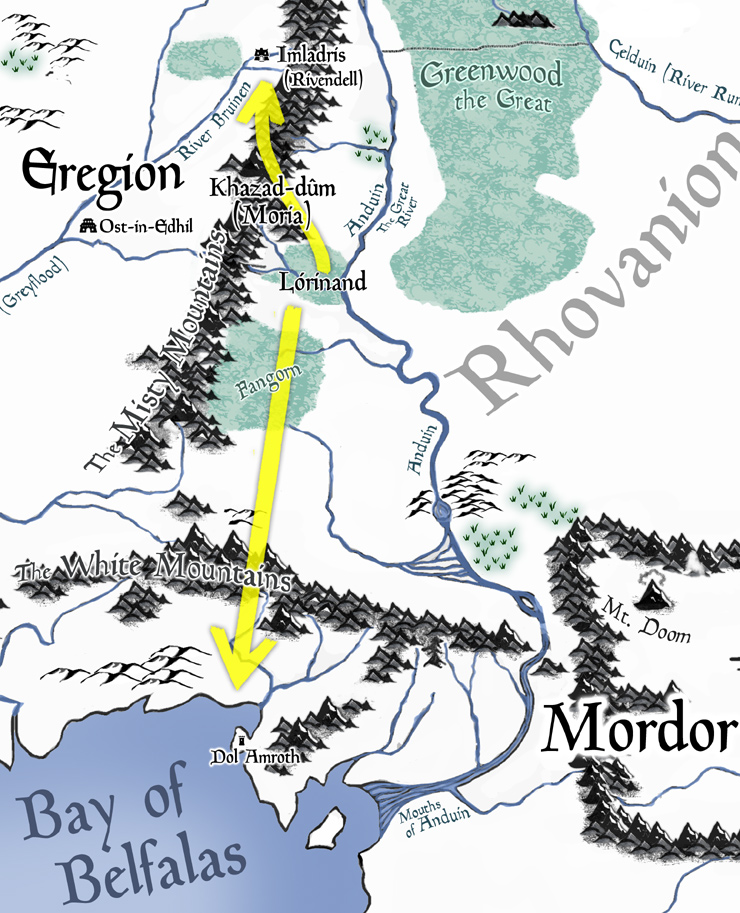
By this point, Galadriel’s longing for the sea had reached a new level. She couldn’t stay where she was, so far from the water, so she left Amroth in charge of Lórinand and traveled to the newly founded Imladris (aka Rivendell), to meet up with her husband again in the aftermath of the war. She brought Celebrían with her, and this is where Elrond first saw his future wife. Being Tolkien, this was love at first sight, but Elrond was too shy to say anything to her. It’s fine. He’s got time.
A capital-c Council was held, and they all decided that Imladris would be the Elvish stronghold of eastern Eriador (with Lindon being in the west). The other two of the Three Rings made by Celebrimbor were properly placed: one with Elrond, one with Gil-galad (who would later give it to Círdan). Things are looking like they might be peaceful again for a long while, at least. Sauron had been driven out. Of course, none of them realized that in that war…
the Númenóreans had tasted power in Middle-earth, and from that time forward they began to make permanent settlements on the western coasts, becoming too powerful for Sauron to attempt to move west out of Mordor for a long time.
Galadriel’s story in this tale wraps up a bit suddenly. At some point later, and because of her sea-longing, Galadriel and Celeborn took their daughter and traveled far to the south into the coastlands known as Belfalas. This region would later become known as Dol Amroth, one of the principalities of Gondor. Here she dwelled with her family until well into the Third Age when new dangers to Lórinand required their return.

Now we come back to The Rings of Power show, and the version of Galadriel we’re going to see. We’re getting a Lord of the Rings and Appendices Galadriel. She’ll still come from Valinor, but we will not have rebelled-against-the-Valar Galadriel, or a friend and protégé of Melian Galadriel, or even grieving-for-the-loss-of-four-brothers Galadriel. We will have an angry and vengeful Galadriel, whose brother, Finrod (the only named sibling in the Appendices), “gave his life” at some point in battle. (I will have more to say about Finrod another day.) They’ve remade him into a hunter of evil, so with his death, she will now become the hunter. The motivation, the chronology, the particulars—it will be different because, again, Amazon does not have the rights to The Silmarillion or Unfinished Tales, or really, anything else.
But if you read Tolkien’s own ideas, of the many hats and faces Galadriel has worn in his imagination—sister, daughter, commander, fighter, leader, organizer, facilitator—you will come away with a character who is restless, passionate, and powerful. And a little bit flawed; she may be overly proud and imperious. That would track. From all they’ve said so far, JD Payne and Patrick McKay seem to be familiar with most of this material, even if they can’t talk about it directly. And so they, along with Morfydd Clark herself, may have found ways to portray her character in keeping with Tolkien’s ideas. I believe they are at least trying. We can all decide individually if they meet our expectations.
So who’s most out to get Sauron in this new series?
Why, Lady Galadriel, in Middle-earth, with the Dagger. Of course.
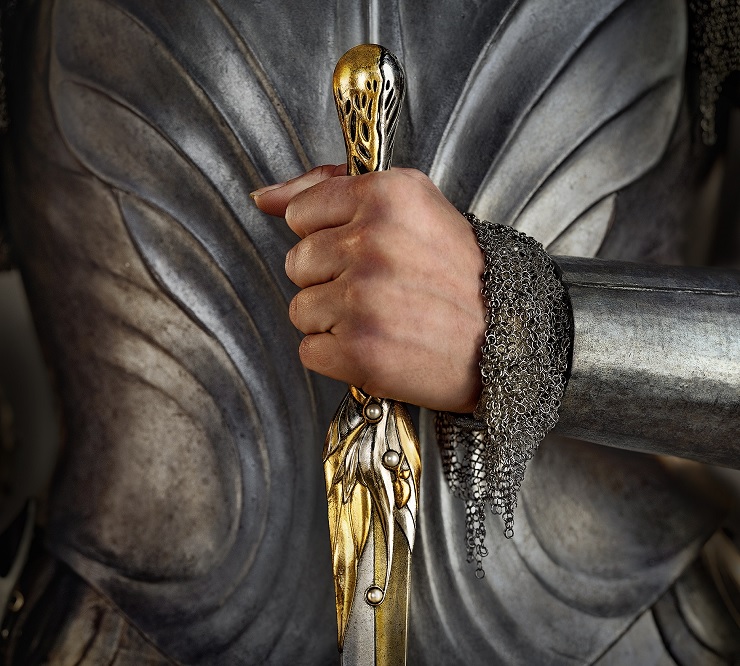
Jeff LaSala is responsible for The Silmarillion Primer, the Deep Delvings series, and a few other assorted articles on this site. Tolkien nerdom aside, Jeff wrote a Scribe Award–nominated D&D novel, produced some cyberpunk stories, and works in production for Macmillan and the Tor Publishing Group. He is sometimes on Twitter.











A fantastic article, Jeff. I really enjoyed it, and it should enhance readers’ appreciation of The Rings of Power.
Of course, Tolkien’s ultimate intent was that Galadriel had only three brothers, not four, but that’s a whole other story, as is Celebrimbor’s unrequited love for her…
This is why I roll my eyes at people on the internet who complain about how the Galadriel of The Rings of Power trailers doesn’t match their opinion of what exists in their minds as the “real” Galadriel of the Second Age. There really isn’t a “real” Galadriel of the Second Age. Her story is a total mess, and Tolkien was rewriting it (and bigging up her role in it) all the way up till the end of his life. The show is in the unenviable position of depicting something on the screen that even diehard fans have very different opinions about, and with limited licensed material to work with. I just hope people give it a chance.
I think its pretty clear that Rings of Power will have very little to do with what Tolkien actually wrote; Galadriel’s nebulous story notwithstanding.
@3 – Well, Amazon only secured rights to the appendices, so…they literally can’t use anything he wrote.
@@.-@: The situation is vague. They’re clearly using elements that are simply nonexistent in LotR’s appendices – the map of Numenor is the absolutely massive giveaway – so they must have acquired some rights to use material from Unfinished Tales (where the map of Numenor appear) and probably The Silmarillion. There’s been some discussion that they are able to use additional material in an incredibly limited context and they do not have the rights in full to anything other than LotR and The Hobbit. How that would work is unknown, but potentially intriguing.
Let’s apply here the principle of Occam’s razor.
What is more likely, that the new series’ Galadriel is depicted literally as a warrior because we can assume that Tolkien’s absence of clarity somehow left an open door for the showrunners to take subtle decisions based on what Tolkien indirectly (or non-deliberately) pointed at through many obscure clues, though limited by the rights these showrunners own?
Or should we assume that Galadriel, clad in armour, is just the result of needing an iconic LOTR female character who can be physically involved in the battles and adventures of the series’ plot, following the same path as others had done in weak fantasy adaptations such as Tim Burton’s Alice in Wonderland or Kristen Stewart’s role as Snow White?
Summarising it all even more, is this warrior Galadriel the result of an intense investigation/knowledge of Tolkien’s literary corpus or another Disney princess with a sword?
Congratulations on your awesome investigation, by the way. I have learned a lot.
Fantastic article. It’s been a long time since I read “Unfinished Tales”, so my ideas of Galadriel are mostly informed by LOTR and The Silmarillion. And really, all that boils down to is that by the Third Age rolls around, she is the most powerful elf in Middle-Earth. It makes for a fascinating discussion on the nature of what is canonical when the bulk of an author’s work is the post-humous publishing of his unfinished works and notes.
Nothing Tolkien wrote about Galadriel even remotely resembles what we’ve seen from Amazon. They barely had anything to work with. This means they had a ton of wiggle room and grey areas to fill in. But instead they took what little they had and tossed it all in the trash to start over completely. Only the name remains in any way true to Tolkien.
I disagree. Last week at the NYC premiere I saw the first two episodes. Galadriel’s circumstances are different because they have to be (more’s the shame, yes), but the spirit of Tolkien is not wholly absent. They’ve captured a lot. It’s rearranged. But it’s there, and it’s quite engaging.
@8: Galadriel was a military leader (she led armies even during the War of the Ring), a political leader (from everything else), she engaged in “athletic feats” and Tolkien ummed and ahhed at great length whether she took part in the Kinslaying at Alqualonde as an actual combatant (probably influenced to some extent by fan letters appreciating that element present in LotR via the character of Eowyn and pondering if The Silmarillion required a similar role).
It’s clear that Amazon have dramatically exaggerated what was a minor trait, at best, in the legendarium, but it is also clear that the depiction of Galadriel as a strong leader capable of mixing it up in person if absolutely required was not foreign to Tolkien’s depiction of the character. It is also fair to say that it is an exaggeration, and Galadriel leading a rumble squad of elven commandos across Middle-earth searching for Sauron is a story idea that would likely have Tolkien blinking at the page in confusion, as much as Legolas air-surfing up an oliphant’s trunk, Saruman being impaled on a water wheel and Elrond magically teleporting instantly from Rivendell to Rohan and back again just because the writers forgot about the reforging of Narsil.
Thanks Jeff, amazing article as always. You touched on this briefly and it caught my attention: what exactly were the Rings supposed to do? Like, are we talking Captain Planet style powers here? I never really understood and would appreciate any insight
Why did it matter to Lothlorien that her ring lost its power when the One Ring was destroyed– “Lothlórien’s power begins to fade (because Galadriel’s ring loses its own power)”? She wasn’t wearing it anyway, so what help had it been doing?
Good stuff in your usual style Jeff :^) Tolkien took me in my grade-school years and is a big part of whatever the heck I am today.
His rewiring of family trees in the Younger Days definitely makes my brain hurt; Celebrimbor is the son of Curufin, sorry but that’s not negotiable after 40+ years of Silmarillion research!
“For all that we make fun of Celeborn (who can blame us?), one person who never does is his wife.”
So true. BORED OF THE RINGS nails it by naming the equivalent character “Cellophane.” (Yes, I know the Elvish “C” is supposed to be hard, like K, but c’mon, poetic license in the service of laughs…)
“And look, she’s going to be using a sword…”
Is she? Tolkien does not say what she used. She could have used a bow as the Teleri she was defending did. Or picked up an oar or a boat hook or…
More seriously:
“…and wearing armor.”
I don’t think so. I may be mis-remembering, but Tolkien notes shields and helms for the Noldor in Aman, but not body armour (i.e. mail). That does not seem to have been adopted until they got to Beleriand (the Dwarves having invented it).
Plate armour is all wrong (Tolkien mentions vambraces and greaves in the early Fall of Gondolin tale (and with Imrahil using his vambrace to check Eowyn’s breath). But no breastplates, backplates, rerebraces, faulds, spaulders etc).
@@@@@#10 “Galadriel was a military leader (she led armies even during the War of the Ring)”
Tolkien attributes the ‘leading of armies’ to Celeborn:
“Celeborn came forth and led the host of Lórien over Anduin in many boats. They took Dol Guldur, and Galadriel threw down its walls and laid bare its pits..”
LotR, App. B
@11, re: the Rings of Power. We’re not told what, say, any particular of the rings are meant to do, but we can infer a lot. Consider the Three and their preservative (yet elemental-based) powers. I think the other sixteen were similar, but probably lesser versions of the same. To deduce what they’re meant to accomplish, I think we have to consider Annatar’s tricksy words. First he points out that though they obviously miss Valinor, the Elves surely love Middle-earth and don’t want it to “desolate and dark”?
Basically, it seems the rings are meant to simply increase the Elves’ power to make the world around them more fair. It’s all a little vague, but that’s the idea. If the rings did as Sauron is suggesting, they could make Eregion (and other places they go) as “blissful” and “fair” as Eressëa or even Valinor itself! Of course, he’s lying, isn’t he? Maybe they would increase one’s personal power, but the real purpose behind them is to make their wearers fall under Sauron’s control.
Even the Three don’t end up achieving anything as grand. Imladris/Rivendell and Lothlórien are amazing places when the Ring of Air and the Ring of Water and used to protect and enrich them, but they’re still not like those cities in Valinor.
@12, can you rephrase this question? I’m not sure what you mean. Galadriel didn’t toss away her ring. But when the One was destroyed, Nenya’s power (like Narya’s and Vilya’s) faded.
@13, yup. I can’t imagine Celebrimbor being a Gondolin Elf unconnected to the Fëanor (which he was at one point), and I certainly can’t easily rewire my brain into thinking of Gil-galad as not having been the son of Fingon. But for all that Tolkien’s writings were tangly, it must be remembered that we (well, Christopher first) went nosing around into his unpublished notes. Pick any really good, really prolific writer and go look at the mess of early notes and computer files; it won’t all be tied up yet. They weren’t done. And that’s probably true even with authors who weren’t otherwise academically employed and had four kids and chaired societies and corresponded with handwritten letters with tons of people.
@15 I would need to check various entries in The History of Middle-earth series. In The Silmarillion, right, we don’t get explicit mention of “mail” on the Elves until Fingolfin’s challenge to Morgoth in single combat quite a bit later. But he’s been living in Hithlum, interacting with Grey-elves. I don’t believe he’s been working with Dwarves in the way that Thingol had. But back when Melkor inspired the Noldor to first make swords, they’re were also making shields and helms. That’s explicit. I can’t imagine they’re making up all this metal protective gear and just forgetting the torso. Whatever it is they constructed, even if it’s not chain mail, they’ve got something. They were pursuing Morgoth to wage war with him. So I don’t buy that they’re walking around without armor.
Tolkien can be frustratingly sparse on details. There’s also no mention of a lot of the things the Noldor clearly ended up bringing with them on their march out of Valinor that the text only mentions later. Like . . . horses! Like Huan! Like gobs of treasures! (We’re told Finrod brought the most gems, etc.) It makes me wonder if they constructed special wagons that had to get upgraded right then and there when they realized they’d have to pass through the Helcaraxë! It seems like they were hauling chests all that way. The Noldor are inventive. Hence I imagine some kind of wagons involved.
AND . . . are we really supposed to imagine that Fëanor, who was on his way to Angband directly, and never once interacted with Dwarves, and who was intending to “come at Morgoth himself,” was wearing a nice thin Elven robe only (just with a helm and shield)? It’s absurd. He was prepared for war, as all the Noldor would be. This is why the Kinslaying wasn’t fair even on that level. The Noldor were ready for conflict, the Teleri were not. Galadriel wouldn’t be going around in monk’s attire. I just don’t buy that they’re not armed for conflict with Morgoth.
@16, and yes, I agree: Celeborn is very definitively made a leader of actual armies on a few occasions. He’s the more militant. But this pretending that Galadriel is uninvolved and stays away from all conflict that so many people keep on insisting is disingenuous.
re: armour:
I am referring to what is said in HoMe, not the Published Silm.
Dwarves are the ones who invented mail, and there is no mention of armour (beyond helms) for the Eldar in Valinor (barring something I have forgotten).
Thus claiming that they armoured is what you are imagining, not what Tolkien said.
“But this pretending that Galadriel is uninvolved and stays away from all conflict that so many people keep on insisting is disingenuous.”
Tolkien is quite clear that she was involved; Celeborn and the host of Lorien took Dol Guldur, and Galadriel threw down the fortress.
@18 It might not be in the text but I a have hard believing that the Noldor would invent swords but not a way to protect against them. If for no other reason than armor is a much more interesting challenge than swords or shields. The torso is also the body part you armor after the head. Which means if vambraces or greaves are mentioned you can infer breasplates or mail or something providing chest protection.
I honestly don’t think this is the only mention, but here’s something from Morgoth’s Ring, volume 10 of The History of Middle-earth, in any case.
#19 Weapons came before armour (in the real world). Dwarves invented mail. Dwarves were not in Aman.
Hence, the Noldor were not ‘armoured’ until they came into Beleriand (and learned of mail).
The greaves and vambraces (from the BoLT, FoG) are after the Noldor went into exile.
I’m referring here only to armoured Noldor in Aman.
Tolkien mentioning the Noldor having armour (beyond helms) in Valinor. would need to be shown.
As above, so below. This one’s from The Lost Road and Other Writings, volume 5.
Galadriel sure would have worn armor during the Kinslaying, unless one imagines she alone did not for some reason contrived by the reader.
The Silmarillion says that the Dwarves were the first to contrive the making of mail of linked rings, and that they were never surpassed in this art, but I think having them invent it in Middle-earth (since they needed it for fighting Orcs and each other), and also having the Noldo later independently invent it in Aman (with some hints from Melkor), is not an unpalatable solution.
A good point, Tonyz. And given that Aulë made the Dwarves and also taught the Noldor, and the fact that later the Noldor would have compared notes with the Dwarves, well, it works nicely. Which cannot be said of lot of other aspects of the legendarium. ;)
Excellent. Thank you.
So in QS it was:
“But the Gnomes now learned the fashioning of swords of tempered steel, and the making of mail; and they made shields in those days and emblazoned them with silver, gold, and gems.”
Lost Road, QS
CT comments in MR LQS:
“In QS, where the matter first entered (V.228, note by Pengolod to §49), it was said that ‘the Elves had before possessed only weapons of the chase, spears and bows and arrows’, but that now, under the influence of Melkor, the Noldor ‘learned the fashioning of swords of tempered steel, and the making of mail’ and shields.”
The passage referred to is:
“It is told, also, that at this time Melkor would speak to the Eldar of weapons and armour, and of the power that they give to him that is armed to defend his own (as he said). The Eldar had before possessed no weapons, and since the chaining of Melkor the armouries of the gods had been shut. But the Noldor now learned the fashioning of swords of tempered steel, and the making of bows and of arrows and of spears; and they made shields in those days and emblazoned them with devices of silver and gold and gems.”
MR, LQS
Melkor speaks of armour, mail is removed from the passage, the Noldor learn to make weapons, and make shields, no mention of armour/mail being made.
While in the Annals of Aman:
“Melkor spoke to the Eldar concerning weapons, which they had not before possessed or known; for the armouries of the Valar after the chaining of Melkor were shut.
But now the Noldor, began the smithying of swords and axes and spears; and shields they made displaying the tokens of many houses and kindreds that vied one with another.”
No mention of armour/mail.
Tolkien changes this a bit, noting that the the Eldar must have had weapon on the Great Journey:
“It is told also that when Melkor saw that these lies were smouldering he began to speak, first to the sons of Feanor, and at other times to the sons of Indis, concerning weapons and armour, and of the power that they give to him that has them to defend his own (as he said). Now the Quendi had possessed weapons in Middle-earth, but not of their own devising.”
Retains mention of Melkor speaking of armour.
” But now the lords of the Noldor took out their swords and spears and sharpened them, re-strung their bows and filled their quivers with arrows. And they made shields in those days and emblazoned them with devices of silver and gold and gems. These only they wore abroad, and of other weapons they did not speak, for each believed that he alone had received the warning.”
While Feanor “wrought fell swords of tempered steel for himself and for his seven sons, and tall helms with plumes of red.”
So, preparing weapons, making shields and helms, no mention of other armour being made.
This would seem to bring it in line with:
“Their [the Dwarves] smithcraft indeed the Sindar soon learned of them; yet in the tempering of steel alone of all crafts the Dwarves were never outmatched even by the Noldor, and in the making of mail of linked rings (which the Enfeng first contrived) their work had no rival.”
WotJ, Grey Annals
“They [Dwarves] it was that first devised mail of linked rings, and in the making of byrnies and of hauberks none among Elves or Men have proved their equals.”
WotJ, LQS, Concerning Dwarves
I will modify my initial statement to, as Tolkien developed the tale, the Noldor do not seem to have possessed or made armour/mail (other than helms) until they returned in exile to Middle-earth.
The fading of the power of the Three has always struck me as an example of theme being more important than plausibility. It’s the right call because it’s thematically important. But really, we have these rings of power made by an elf, with elven techniques and his own personal lore. Sauron never saw them and was not even aware of their existence when he made the One Ring. But they did already exist–they were made, and presumably had power already, before the One was made. They in no way drew their power from the One.
In short, there is in causal terms no connection between the Three and the One whatsoever. There is zero direct reason why the One being destroyed should have any impact on the Three. They fade for reasons which are almost explicitly thematic and abstract: The Age has ended, the elves’ power is waning. Stuff is just getting less magicky because it seems to fit how the world wants to be now. And that’s just more important in LoTR than whether it makes any actual direct . . . sense.
#26:
Tolkien notes of the Three Rings:
“…for the Three Rings were precisely endowed with the power of preservation, not of birth. Though unsullied, because they were not made by Sauron nor touched by him, they were nonetheless partly products of his instruction, and ultimately under the control of the One.”
Letter 144
This was a really good summary! It was really helpful to review the different storylines in Unfinished Tales (which I’ve only read once so don’t remember in great detail).
As an aside, I had no idea that Clue only showed one ending in the theater!! That’s unbelievable. So someone could watch the movie, then the next day talk on the phone with their friend in another town who had also seen the move; and they both could have seen a different ending without knowing it?! What a world.
The real point is that it doesn’t make sense to balk at the idea of Galadriel, one of the Noldor, wearing armor. Heck, even some good leather armor banded with metal. Whatever. Shaking one’s head at the notion is absurd. We might as well “boggle” (as he Tolkien to say) at the idea of a depiction of Middle-earth where the Sun hadn’t existed all along just because he started to go back and revisit the cosmology. Yet the published Silmarillion, and this show, depicts a world where The Two Trees came before there was sunlight, per Tolkien’s earlier (and more complete) writings.
And yes, quite right. It makes far more than zero sense that Galadriel’s ring loses its power when it does. The bottom line is that the Three Rings were made by Celebrimbor using the same knowledge that he’d gained from Sauron. If this wasn’t the case, why wouldn’t they use them much sooner? Notice how nervous they were to even have them, and Galadriel’s insistence they stay out of Eregion. They hid them away until Sauron’s apparent fall at the end of the Second Age.
“The real point is that it doesn’t make sense to balk at the idea of Galadriel, one of the Noldor, wearing armor”
My point is about the (assumption of the) Noldor in Aman wearing armour, not (just) Galadriel).
“…the idea of a depiction of Middle-earth where the Sun hadn’t existed all along just because he started to go back and revisit the cosmology. Yet the published Silmarillion, and this show, depicts a world where The Two Trees came before there was sunlight, per Tolkien’s earlier (and more complete) writings.”
Considering that the LotR does not depict that world (and even contradicts it in some ways), and the Hobbit was deliberately revised to have an extant sun and moon, ‘the show’ should depict the sun co-existing with the Two Trees.
Another wonderful, in depth dissertation!
Is your Silmarillion Primer only online? Or is or will there be a book form available? Your writings have
clarified much on my mind and peaked my curiosity.
past time to dig back into the Silmarillion!
Also want to offer apologies for straying off topic
in response to another piece. It is hard to not think of several things at once, especially now with Rings
of Power coming out officially (tonight?) Cool that you have already seen the first two episodes.
As for Galadriel’s athletic skills, my imagination has
would think she did more than just participate in swimming and climbing contests. So maybe doing the practice dance with sword or bow and arrow could be believable.
But because she has this Other incredible otherworldly
presence, wisdom and magic by the time we meet her
in LOTR…I can understand why the focus on physical fighting could feel like a pull away from that…except
for that hint of Galadriel’s intuition. I felt Cate Blanchett was exactly as I imagine after reading the books.
And what I loved about her portrayal was that “other fey” quality. Or elemental quality…she had power not to be messed with but knew her limitations. But was kind as well…to Gimli etc. Though her eyes bore into Boromir. The subtle fey smile as she boards the ship into the West felt just right to me.
She is not human (but she cares about other beings on middle earth)
Since elves do have that connection to Arda…one I think of as elemental. I hope that will be shown.
Because they are long lived, it could be easy to just focus on elves feeling “elite and haughty.” But it seems like a fine balance.
You quoted Galadriel’s song/poem. I seem to remember that from the Swan Boat and she held a harp.
I understand why Jackson was limited fitting in such poetry and my hope is that perhaps with a series, that side of elvish culture can be shown more.
I think a pendulum sort of swings back and forth
with Tolkien’s works. Some outside of knowledge of his writings have claimed there are no women doing things…but I came across your wonderful essay on Luthien.
and I remember when I discovered her in Tolkien’s writings my mind was “blown!”
To me giving Luthien a “sword” if anyone had rights to that would be a “huge mistake” and a “sad one,”
not understanding how her story/ballad plays out.
Luthien certainly does not sit still…and the fact she faces all those challenges without a sword but some help Huan (love that dog) It makes the story even braver. Seems like in addition to singing down Thu and Morgoth/Melkor.
in the ballad Luthien also faces off Morgoth with a little inventive um choreography or um moves.
By Varda she has nerves of steel! Especially the singing down Sauron! For me a re-invention of Luthien’s character would seem “trite” in the name of action for action’s sake.
But with Galadriel I can see how there is room to wonder.
As for the actress Morfydd Clark…they have her
with her hair dyed blond. She is also Welsh (in a wider sense a British actress)
In addition her cheekbones do remind in aesthetics of Cate Blanchett. Unlike Game of Thrones where some stark kids did not have their expected red or copper hair…Galadriel comes as “expected.” I think that is something.
Now my only question is her voice…nothing against the actress…she has a pretty voice but it’s a bit softer and higher than I might expect or imagine for Galadriel. Yes I’m guilty of having Cate Blanchett’s delivery echoing in my mind.
Maybe another 2000 or so years brings a deeper voice. Chuckle. I really don’t know. It is a slight thing.
Morfydd Clark’s voice reminds me more of a “faery of Avalon” (who could go by the name of her ring Nenya.)
than a powerful elven mage/being of Valinor. In my mind that depth of voice would already be there even when Galadriel is younger (for she has already seen an age.)
But it’s a small quibble and I’m curious to see the show tonight.
One other thought on wandering elf women.
Didn’t the King of Gondolin have a sister who was “want to go riding off by herself” here and there?
Though he was not too happy about it and worried for her? And maybe she crossed into Beleriand or Doriath? Though I may be mixing timelines up since it’s been awhile. Of course these tales are under the protection clause. But it proves there is much more to Tolkien than meets the “casual fan’s” eye. (Things I am still learning too…thanks to sites like this!)
Christopher Tolkien approached Amazon?
This surprises me a little…because as protective as C. Tolkien was of his father’s works…Amazon is kind of commercial. But it is what it is.
If C. Tolkien was not crazy about Peter Jackson’s interpretations going to Amazon but limiting rights to other works seems strange. Especially as limiting rights to Silmarillion and all opens a much broader door to “inventiveness” and “creative license,” than even Jackson had. (No judgement here. Just observation) And yes I know the writers were working with Tolkien scholars. But C. Tolkien might have guessed there would be big changes afoot to fill in gaps. Unless he thought LOTR would be re-made? Again? Not Appendices 2nd age?
Its kind of strange. But is what it is. And I appreciate all the work C. Tolkien has done on his father’s writings.
My take is there are so many modern running shows
with sub sub plots (not just GOT WOT fantasies),that modern audiences are used to that and expect that, whether Downton Abbey, NCIS or GOT.
I personally cannot imagine Tolkien veering off in act two about Eowyn’s “sister’s” failed marriage or the black smith and his wife’s second child as The Shadow approaches. Or Eowyn secretly training the village women sword, while she also works as a “healer” in the village…
But this kind of “filling out” is expected today for broader interest sake. It is a different kind of era. Even more so than when LOTR films came out.
Searching for an audience beyond Tolkien readersor even LOTR film enthusiasts would explain this to me. And with limited material to use this seems bound to happen.
I’ve gone back to being uncertain about “buzz cut” or short haired elves (is that Finrod in flash back fighting also with short hair?) Feels odd.
If this was explained as a punishment from Morgoth (ala what happened to some Native Americans here in US), it would make more aesthetic sense. Or even the elves shaving hair in grief (not completely Tolkien) but symbolic of “the weeping of elves.”
Instead, it looks like it will be a class distinction between some elite elves with longer hair and Sylvan military elves of elf working soldier class? Except for short-haired Finrod? And Celebrimbor?
I think that’s part of the modernizing thing…and maybe for some movie goers of the past who might have thought short haired elves would be “more interesting,” or that the movies and books were too long. The modern “cool factor,” to engage new audiences.
But sometimes I feel a little old fashioned and don’t want to be directly reminded of our present “middle earth” (nothing against Arondir actor, but he would be very striking with longer dark locks…plus his eyes have a slight grey tint anyway. Think it would give him even more of an elemental feel) I understand there will be emphasis on being an “elf soldier,” but want a little more than that alone. As much as “relatable” and “relevant,” have become an intrinsic part of all modern story telling…Sometimes I want something that takes me a little out of this world and does not pull me back in. (Which feels a little too unsubtly allegorical.) Except, (alas!)Tolkien knew his stories could resonate in ALL times. Because of those deeper themes. But that takes it beyond allegory for me.
And his books were loved beyond the British borders long ago…because of that.
So guess it will be a wait and see tonight.
I am quite curious.
I still wonder if Nori Brandyfoot is a nod to the Unwritten Belladonna Took but that’s a question for another time.
Suffice it to say Jeff, I have enjoyed reading your various treatises on the history and characters of Tolkien’s Middle Earth and Varda! Very enlightening and interesting. Appreciate your knowledge.
Have you ever written anything on Tolkien’s dream of a giant wave?
Or Tolkien commenting on part of the stories being “written through him.” This goes down to a fascinating subconscious or higher consciousness of inspiration.
I know of some of Tolkien’s real life influences, inspirations and studies…but has always felt to me he was creating “art,” much akin to what he says about the power of the elves’ magic. Or perhaps Tolkien would say “co-creating,” grin.
With all of your knowledge of Tolkien’s writings and history …I would love to see your thoughts on this!!
And by now think “Galadriel” knows all the consequences of choices fighting, (spiritually or physically) or not-fighting. All the after affect. The “Test.” What is done stays with you I suppose through all those ages…(sadness, anger) and what will you do and where will you go from there? Love Galadriel…awesome character.
Okay just “wandering” in the mind realm of Arda/middle earth a little longer.
”Ground Control to…” laugh!
I find the “Galadriel going to Numenor” and “No sign of Celeborn” who she was clearly with in 2nd Age the worst from RoP. We clearly know that she did not do that and yet here we are.
Late to the discussion, but the Hobbit confirmed elves wore armor.
“With that he put on Bilbo a small coat of mail, wrought for some young elf-prince long ago. It was of silver-steel, which the elves call mithril, and with it went a belt of pearls and crystals. A light helm of figured leather, strengthened beneath with hoops of steel, and studded about the brim with white gems, was set upon the hobbit’s head.”
Excerpt From
The Hobbit (Enhanced Edition)
J. R. R. Tolkien
I don’t think anyone was disputing Elves wearing armor at all, just whether they had armor at a certain point in time (in Valinor, and as they were leaving it). Which, like Galadriel herself, Tolkien went back and forth on. But the idea is, they’re not silly enough to go unprotected as they proceed toward war.
Armor in Gondolin makes even more sense. In fact, The Silmarillion goes into that even more, with Maeglin’s ability to find good ore for the making of arms.
Thanks so much for this thorough, well-documented overview that rather shows this ROP Galadriel is there, in all her aspects, in Tolkien’s mind.
Also, well-written, organized, structured.
The title cards were excellent illos!
I have changed my mind about Morfydd Clark’s voice.
Even though her voice is soft, she delivers lines in a measured way, which gives it a deeper feel. I needed more than previews to hear that.
And speaking of Galadriel…any thoughts about Finrod’s answer to the young Galadriel’s question about the difference between Real Light and Reflected light?
I think Finrod says (my paraphrase): “First you have to touch the darkbefore you can know (the real) Light.” And young Galadriel looks surprised and inquisitive.
It felt a bit strange to me. Experiencing (the dark), feeling the shadow, facing the dark make sense, but this sounds more like a call to seek the dark in order to find the light. Not something I would normally relate to a Tolkien work or the kind Finrod.
Maybe it’s more like if one “learns about the dark,” then they will be more prepared or better understand the Light? Or maybe I’m missing something. And there is another view to this?
Any thoughts?
Since I’m not a particular fan of this version of Finrod (more about that, and the show in general, I’ll be sharing in a week or so), so it’s hard to say what I think about this learning about the dark talk. Rather: “Sometimes we cannot know until we have touched the darkness.” That doesn’t feel like a very Finrod thing to say (the Finrod from The Silmarillion).
And it calls to mind Elrond’s observation about Saruman when Gandalf finishes his tale of Saruman’s betrayal (at the Council of Elrond):
Glad to know I am not the only one!
Will look forward to your next post in the coming weeks. While I watch and see what happens next in this show…which does feel a little “Middle Earth 2,” as someone pointed out elsewhere.
Super well written.
Two thoughts. Amazon’s Galadriel is written as she is written to put a female in the role of lead warrior hero. Not just warrior. Not just leader. But lead warrior hero. That is 21st Century political sensibilities, not Tolkien. In fact, anti-Tolkien.
Second, crafting Galadriel as desiring to be a man-like warrior rather than as a super powerful female leader really harkens to the Eowyn story. And there, Tolkien is quite clear about his thoughts on females desiring to fill a male warrior role rather than doing their appointed part. Maybe first part of the First Age Galadriel was not mature enough to know her place and role, but married, mother, Queen, top Elven Leader Galadriel would not be running around Second Age Middle Earth like a Captain. Eowyn learned that by in early adulthood, and so would Galadriel.
Thanks for reminding me how tangled this is – I read through these several years ago they were all mixed in my mind.
For my own sanity, I consider the published Hobbit, LotR and the Silmarillion to be as ‘true’ as they can be (even with some of their own inconsistencies) and am fine with some of the Unifnished Tales/HOME stuff as far as it doesn’t contradict it. It’s interesting to see what Tolkien might have done, even if i don’t actually like some of his plans. I was never a fan of his idea that the sun/moon should have always existed, and I know at least part of his desire to keep re-telling Galadriel’s story is in part because I think he didn’t want her to be as flawed, but I’m also fine with that.
As for ROP, I don’t know. I haven’t watched it yet, and I honestly don’t know when/if I’ll be able to. There’s just so much negativity/drama around it, it’s pretty much killed my enthusiasm (plus you are telling me they’ve effed up Finrod? Sounds like they are giving him very Jackson-Faramir type justifications and I can’t really handle that again, haha).
I actually think it’s very true that Galadriel was way more pro-active and militant than we give her credit for, but I could also see them taking that and running with it in a very focus gorup-y ‘this is what modern audiences want’ way and as I don’t think they did a good job with the Wheel of Time show (I was more or less with it until the season finale, which I found very awkward), it will remain to be seen what they do here.
On the other hand, in part because the second age is so sparse, not to mention they may not have all the rights to everything, I can try to accept it as just, ‘here’s an inspired story, for a different medium’. Another ‘what could have been’.
@41 – honestly, I am fine with going against whatever Tolkien thinks about that, because it’s a toxic, harmful belief so I don’t think we have to keep propagating it. Not to mention that I think you are over stating what Tolkien thinks as the ‘proper’ place for women as a rule anyway, or that being a warrior automatically takes away their femininity. Especially when Galadriel from the start is talked about as having ‘man-like’ strength and that is never seen as a bad thing. Her pride, in some versions, yes. (I also don’t think the narrative is saying Eowyn was wrong to fight either, but rather for pursuing her hopeless death wish, and over-glorifying battle, which is something Faramir also talks about.). And there are also writers in the Catholic tradition (St. Edith Stein for one, even St. JP II) who talk about women having many types of vocations. So, no, as Edith Stein would way, Galadriel wanting to be a warrior (if that is how they are going to portray her) is not going against her ‘natural vocation’.
I agree it might be agenda driven for other reasons, or maybe they are going to over-emphasize that aspect of her character to be cool and modern. Then again, I haven’t seen it yet, so you might be reacting to some specific aspect (sounds like she’s actively scouting around middle earth?). That makes me eye-twitchy for story/lore reasons but given how compressed the time line is…it’s hard to even say at this point what the characters ‘should’ be doing at any given point. I agree that Galadriel’s story is interesting/worthy/strong enough without that, but they also might not be able to tell that story (any of of them). We know that in all her iterations she opposes Sauron and at least has the ability to fight.
I think if the show was clever, they’d have it so that Galadriel has completely misread the situation with Sauron and he’s spent the past centuries/millennia trying desperately to recant of his sins. However, he’s FAILED at doing so and now he’s the fellow from the sky in the comet.
It will be falling back into old habits and seeing the chaos of Middle Earth that compels him to forge the Rings of Power and become the enemy of the world again.
To Lisa Marie: on Eowyn…I always felt her conversation with Aragorn was multi-layered and her sense for fighting came from a practical view even if she also mentions all “Chance of glory” to be gone…
In the end She Must Fight (Merry as well) to fulfill the prophecy of the defeat of the Witch King…which was once an unsolved riddle “no man can defeat him.”
But Eowyn and Merry could. “I am no man!” Or Tolkien’s archaic “A man I am not!” And yes Merry does get one stab against the Witch King in the movies.
If Eowyn had fallen to proper form the prophecy could not be fulfilled.
Now I have read something Tolkien said on the matter. He suggests that Eowyn is doing what any woman would in such circumstances to fight and defend what she loves. And she says this too.
However by the end Tolkien reckons Eowyn to love peace more than war…so though she was a shield maiden perhaps he doesn’t see her making an “Amazon” career out of it unless at some dire need.
But days of peace have come.
As far as Finrod and the show…Jeff has said he will be writing another article on his thoughts about it in a few weeks.
For me it’s not just so much just a change of Finrod but very little of him. (Guess too much of his fascinating back history is in the inaccessible 1st age)
So that’s kind of sad. I can say this much: anyone who sees the show (having not read the books/other writings) will only remember Finrod as Galadriel’s kind older brother who sadly dies in terrible dark battle. And yes that’s her “catalyst here to go a-wandering.” Unless there are to be more flash backs…?
But alas!
Perhaps, I should save these thoughts until the next posting on the show.
It is middle earth two or a spin off based in the land of Tolkien.
@44 – very beautifully said, regarding Eowyn. (She is actually my favorite character, along with Faramir, and especially suffering from depression, there’s a lot I relate to in some of the things she says/are said about her. The dark walls closing in and all that…). I definitely do not see her ultimate end as Tolkien making some statement about Eowyn needing to ‘know her place’ but rather about warriors and peace and how (as Faramir says, paraphrasing), war should only be loved for that which it defends, and no further.
Anyway – yeah…obviously I should just watch the show before I get all worked up about it. We’re watching some other stuff right now so maybe once we have a little time we’ll move onto that next (although I am admittedly eagerly awaiting Andor).
If they are going to portray Celeborn as Galadriel’s subordinate in EVERYTHING, not just statescraft and magic, but martial affairs as well, it is just as well they don’t have him in this show. It demeans Galadriel as a strong woman that she gets paired with someone who is isn’t her equal in ANYTHING. And that certainly wasn’t Tolkien’s intention, not matter how you want to interpret Galadriel’s perceived slight of Celeborn when we first meet them. Personally, the way I read that scene is Celeborn is thinking as the military leader of his people and he has just been told that he not only has Orcs to deal with at his back door, but also a Balrog (not to mention the Orcs and other powers that are at his front door in Dol Guldur). He is surrounded by enemies, and more powerful ones than he realized. So he spoke hastily (not even getting into his legitimate dislike of dwarves, given he is the close kinsman of Elwe who was murdered by dwarves).
And he certainly is wiser and kinder to strangers that show up in his Kingdom than his other kinsman to the north east, who just throws intruders into the dungeon (and then shows up with an army to steal their gold later and somehow gets treated by our erstwhile hero as the GOOD GUY for all that)
@45, Eowyn and Faramir are my absolute favorites too!. Faramir is far more Human and relatable than Aragorn and, therefore, much more enjoyable. When he and Eowyn find each other in the darkest of days, that is my favorite scene in all LOTR.
Jeff, I tip my hat to your Tolkien erudition. It is outstanding and thorough.
But this:
“The motivation, the chronology, the particulars—it will be different because, again, Amazon does not have the rights to The Silmarillion or Unfinished Tales, or really, anything else.”
So –what, exactly, is The Rings of Power supposed to be? I have watched the two episodes that are out, and they basically look and feel like fan fiction. Big budget fan fiction, but fan fiction nonetheless. It has been truly disappointing to me.
To @45 and @46:
I also love Eowyn and Faramir (I love other characters too) but even in spite of the movie trilogy changes…there is something beyond heart breakingly raw hearing those Norwegian Violins singing across Rohan and seeing Eowyn standing on the precipice looking into the horizon. This was right on…I just cry thinking about it. Because when you have read the books you just know…and then you go back to them.
As for Faramir think now of Eowyn’s lines in the Two Towers about the Sundering Wave…
THIS was always Faramir’s line (though Miranda Otto delivered it beautifully)
But it is Raven haired Faramir who speaks this in the books and it is no mere thing.
For this is also JRR Tolkien’s dream…Tolkien was once haunted by a recurring dream of a giant wave
Faramir’s words are also Tolkien’s.
And when I hear these words it gives me chills.
And then we have these works of Art from Tolkien both inspired from his mind and experiences and perhaps inspired by that undefinable something that reaches other poets, artists and musicians. Who knows?
To @47 yes, I know it does feel like extra fan fiction but “the world is changing…I can feel it in the earth in the water.”
Galadriel? But treebeard in books?
Ten to twenty years ago maybe it might be different,
when adaptations are made from book to screen…bound to be some changes.
But this is hard with so much Not Allowed that creative license will naturally bloom to fill the gaps.
I think Entertainment is expected to win the day over any and all adaptations. It’s beyond what works on screen. Or even taking out a few Ye Thee and Thous…
I think Jeff will probably cover this in the next weeks.
But even the short haired elf aesthetic to “make them relatable? Or more human like? Merely a flawed people (when it’s really And Both mysterious and flawed?)
It feels like it’s about The Cool Factor cause that’s what brings in a bigger audience (ie cutting back the cool Warg magic in GOT for more bloody scenes and trying to keep magic at periphery just in order to gain viewers Outside of Fantasy.
It’s hard when one has read Tolkien’s books or knows how he started a catalyst for so many following fantasy and genre. Or knows how Tolkien created these whole languages or even hears the Norwegian violin in Two Towers and can feel the books calling to be read again.
What can I say? We live in a digital instant age.
We must be entertained quickly (not everyone likes poetry) though some are so eager to return to middle earth (who can blame them) that just to hear those place names spoken on screen or see John Howe’s art again or behold the gold forest of Lindon or Khazad-dum bustling…that is enough to hold them entranced.
I can understand. It’s pretty. I’m just not ”breathing in”Middle Earth quite yet…
JRR We also live in an age where so many shows go for sub sub plots in modern age.
I wouldn’t expect Tolkien to go off on a Tangent in Two Tower’s about Eowyn’s “sister’s” failed marriage
or Eowyn secretly teaching women to fight while mid-wifing for the the black smith’s wife’s second babe.
But in modern time we kind of expect that from fantasy to non fantasy GOT to NCIS and Downton Abbey.
So with this much GAP in appendices now all that plot stuff can be done with all these characters.
Because it’s more realistic “world building?”
It helps me to think of this show really as something unto itself (and I can enjoy it on those merits) just tricky knowing the Tolkien launching base.
The “Whole Entertainment first” philosophy means that “what matters the most is A Show (which will reach many) and The Show must potentially captivate people beyond book fans or even genre fans.
This goes beyond ROP. The idea “yes a book might be a launching pad but The Show is the Kid Born for All everywhere. Whether or not it’s a faithful adaptation of a book. And now Tolkien is becoming more like Shakespeare so I’m betting any book that’s over 30, 40, 50 years old is up for grabs (so outmoded language and the like can be updated as well as character development to appreciate a work foundation but upgrade it like an iPhone so it fits world wide entertainment needs. And the best way to make it relatable and gain more Tolkien fans is to write a translation and interpretation that can be understood by all the modern folk. Cause that would be Cool??
I guess it is what it is. But there I go again. Perhaps something will surprise me in following episodes??
I’m sure Bilbo could make some witty quip here. But I’ll end. Laugh.
I think perhaps thinking of it as fanfiction (or maybe a D&D campaign) might be the best way to think about it. And I like to write fanfiction so that is not necessarily a pejorative.
I kinda like the Shakespeare analogy too, or maybe Jane Austen. Would a purist like the movie Clueless? No. But I think it’s one of the greatest movies of all time. ;)
I suppose it’s just some people playing in the sandbox, mixing and matching elements. It won’t really ever live up to Tolkien’s works but if it gets at least one person to read them, well, that can be a win!
@@@@@ 49: Fan fiction definitely has a place in the world.
My problem with the Amazon series is that it bills itself as a Tolkien adaptation, and then takes a wildly loosey-goosey approach to the original material.
An adaptation of War for the Oaks would probably not be set in the ’80s, and that’s fine. It would lose that wonderful ’80s feeling that the book has for those of us who were adults during the ’80s, but we still have the book for that.
But a Tolkien adaptation with no Celeborn, no Doom of Mandos, no Numenor, with a completely revamped (and rather grouchy) Galadriel having nautical adventures with some random ancestor of Aragorn? Might as well call it “Shazamushka” and go to town, and say that it is “inspired” by Tolkien.
@@@@@ 49 Perfect! That’s it! Great way to describe and approach this. I think the “sandbox” metaphor is true.
Everyone wants to play in Middle Earth makes sense. And mix and match. I only recently found out “Clueless was an adaptation of Jane Austen’s Emma. But that’s a good way to do it sort of a natural evolution. I imagine Jack Black would do a Rock Opera of Shakespeare (ala School of Rock) and it would work.
I’m considering there “might” be flash backs in ROP of characters (BUT they may have to be re-routed or re-written.) I really don’t know. It is what it is.
Something you might be interested in is the animated Rohirrim movie in 2024. It may be strange as it’s anime but Phillipa Boyens was a consultant and John Howe and Alan Lee both worked along side. Plus the story of Helm Hammerhand is narrated by “Eowyn,” : Miranda Otto.
@@@@@50 well it looks like from next preview there will at least be a glimpse of Numenor ships and city. But who knows how it will go *shrug*
War of the Oaks? Do you mean the one written by Emma Bull? Urban fantasy? “Eddie and the Fey?” Pooka dog? That would be interesting to see on film.
Charles Delint stories too…with all the overlapping come to life mythology Irish and Native Canadian.
@@@@@ 51 Yes, Emma Bull’s. She has written better books (particularly Bone Dance, which for me is her masterpiece –and a masterpiece, PERIOD), but none this well-loved. It’s one of my comfort reads.
If it is ever adapted (apparently it was optioned at some point, and a screenplay exists, written by Bull and her husband Bill Shetterly, but it has never come to pass, so far), I will be able to tell every single deviation from the original without even bothering to read it again. That’s how well I know this book.
I highly recommend doing what I call a “soundtrack read.” stopping to listen to every piece of ’80s music quoted or even alluded to in the book. It’s beyond awesome.
I knew it! @@@@@ 52! I came late to Emma Bull just after millennium. Was more familiar with Delint.
Thanks for the recommend “Bone Dance.” Will have to check that out!
I’ve seen episode 3 of ROP now whew! (I’m going to wait until Jeff posts again. Not sure if I was just sleepy today or if my consciousness has been through a ringer laugh. The city Numenor (itself-appearance) that is well done. Very nice! Finally! sweeping aerial-like shots including Argonaut-like visages and mountain tall statues embedded into the land and city. And I almost missed that there is a statue of Ulmo within the inner places of the city? That’s cool.
Yes alas, this still feels different just taking one episode at a time now *laugh.*
Late to the party, but great thoughts here Jeff!
@5 – My paperback copies of the three volumes of LOTR from 1991 had the map of Numenor in them along with the other Middle-Earth maps. I remember because on my very first read I was very confused, wondering when we would see Numenor. But this must be why RoP was able to show that map.
Oh, fascinating, Fernandan! I never even thought it could come down to rights to not just a particular book, but a particular edition of a book.
It was all going so well, and then you wrote “mom’s”.
@56, hah, yes. I take it you’ve not read any of my Tolkien articles before. Not using Tolkien’s wording style (where he tried to limit his language to Old English–derived words) is one of my, err, let’s say motifs.